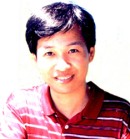

Plenary Lecture
Inverted Colloidal Crystal Scaffolds for Tissue Regeneration, Stem Cell Differentiation and Spinal Cord Injury Treatment

Professor Yung-Chih Kuo
Department of Chemical Engineering
National Chung Cheng University
Republic of China
E-mail: chmyck@ccu.edu.tw
Abstract: The development of innovated scaffolds with pores of inverted colloidal crystal (ICC) geometry is presented in this speech. Sedimentation and floatation of monodispersed polystyrene microspheres leads to particulate self-assembly. The self-assembled colloids are dried, annealed and infiltrated with gels into the interstices of the particle array. The effect of solvent on the regularity of colloidal crystal arrays is in the order of ethanol > ethylene glycol > acetone. The viability of knee chondrocytes in ICC constructs is higher than 92%. The biodegradation percentage of ICC constructs over 4-week cultivation is about 34%. The order in the chondrogenesis is freeform constructs > ICC constructs with pure ethanol > ICC constructs with 95% acetone. However, ICC constructs yield uniform spatial distribution of knee chondrocytes and extracellular matrix. Moreover, the distribution of cultured bone marrow stromal cells (BMSCs) in ICC scaffolds is more uniform than that in freeform scaffolds. ICC and freeform scaffolds can preserve about 63% and 56% phenotypic BMSCs, respectively. The grafted laminin-derived peptides (LDPs) enhance the adhesion efficiency of BMSCs in ICC scaffolds and induce neuron-like cells. An induction with neuron growth factor guides the differentiation of BMSCs toward mature neurons in ICC scaffolds with surface LDPs. In a rat model of injured thoracic spine, the order in the neuronal survival at T10 is BMSCs in peptide-modified ICC construct > BMSCs in peptide-free ICC construct > direct injection of BMSCs. The above therapeutic method in the production of neuronal precursor cells (nestin staining) and axonal growth (neurofilament-H staining) at T10 is in the same order as the neuronal survival. The expression of glial fibrillary acidic protein and tumor necrosis factor-α in peptide-modified ICC construct appreciably decreases, suggesting inhibitions of the formation of glial scar tissue and inflammatory cytokine. The controlled topography of ICC structure with surface LDPs can be promising in guiding the differentiation of BMSCs toward neurons and can enhance nerve regeneration for treating spinal cord injury.
Brief Biography of the Speaker: Dr. Yung-Chih Kuo is a professor at the Department of Chemical Engineering, National Chung Cheng University. His research interests are focused on biomaterials, drug delivery system, tissue engineering, blood-brain barrier, stem cell differentiation, nerve regeneration, cancer therapy, Alzheimer’s disease treatment, biophysics, and colloid and interface science. In these fields, he has authored or coauthored over 100 SCI journal papers. He is an honor member of Phi Tau Phi Society, a life member in various academic Societies including American Nano Society, European Atherosclerosis Society, Asia-Pacific Chemical, Biological and Environmental Engineering Society, Asian Federation of Biotechnology, Asian Biotechnology Directory, Taiwanese Society of Biomedical Engineering, Chinese Institute of Engineers, Taiwan Institute of Chemical Engineers, Biochemical Engineering Society of Taiwan, and Taiwan Biomaterials and Controlled Release Society. He won Young Scholar Award in 2003 and Excellent Research Award in 2010. He is also an editorial board member in 6 journals and has been invited as a manuscript reviewer for over 50 journals (top reviewer of the Journal of Physical Chemistry (American Chemical Society)), an external reviewer for academic awards, research grants, faculty recruitments and promotions, and financial support of hosting international symposiums, and an advisory board committeeman of international conferences and symposiums.